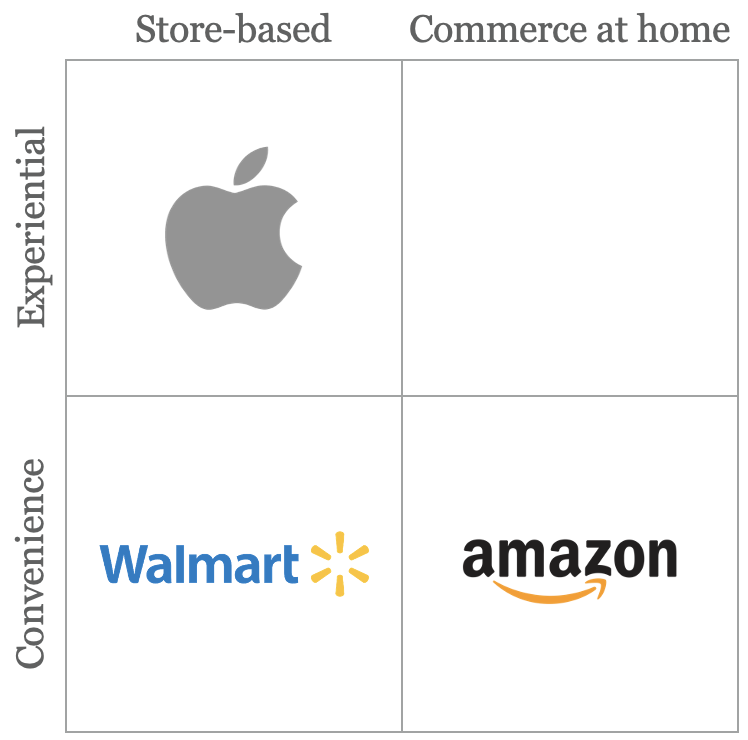This is the first in a multi-part series rethinking ecommerce. The series is based on the following three premises:
- Ecommerce is just commerce at home. Ecommerce is all grown up. It’s time to break away from the early-internet paradigm where online shopping was a new, “electronic” form of shopping. Today, almost all commerce involves varying degrees of digital elements (discovery, price comparison, personalization, selection, ordering, payment, delivery, etc.). The defining factor is not whether commerce is digital; rather, one defining factor is the optimal location for a retailer to meet a consumer’s needs. Shopping happens on a spectrum between home and the store. As such, ecommerce is better understood as commerce at home, and Amazon was the early winner.
- Great retailers focus on convenience or the experiential. In the new paradigm, certain retail truths persist. For example, all great retailers have focused primarily on either convenience retail or experiential retail. To be clear, any retail can be a great experience, but the priority matters. Amazon focuses ruthlessly on convenience. The outcome is a great customer experience. To drive growth, Amazon has prioritized speed and selection over consultation and curation. Amazon’s focus on convenience has yielded an (incredibly) high-volume, low-margin retail business. Apple, on the other hand, emphasizes the experiential. The Genius Bar stands out as one of the great retail innovations of all time, matching Apple’s premium brand with a premium customer support experience. Apple’s focus on the experiential has yielded a high-margin, lower-volume business that other device makers can’t match. Great retailers must deliver a great experience, but they do so by focusing either on convenience, eliminating human interaction, or the experiential, emphasizing human interaction.
These first two premises establish a four-box paradigm to consider:

- There is an open opportunity in experiential commerce at home. Apple has struggled to deliver the same great experience they offer in their stores to customers ordering online and shopping from home. Perhaps the closest they’ve come is a delightful unboxing experience or a well-timed email offering online setup and support just after your new Apple product is delivered. But these efforts fall short. Similarly, Amazon has struggled to execute its attempted experiential elements in the home, like installation and setup. These appear to be all but abandoned experiments. For Apple, commerce at home appears to be outside of its skillset as a retailer. And for Amazon, the experiential appears to be outside of its skillset as a retailer. This leaves open an untapped opportunity in experiential commerce at home.
We’re investors in Enjoy, a technology company that partners with premium brands, including Apple, to offer a high-touch retail experience in the comfort of home. Enjoy is directly addressing the open opportunity in experiential commerce at home.

Your home is now a place of business
Walmart was built on new technologies (cars, trucks, freeways) that unlocked new opportunities for store-based commerce. Similarly, Amazon was built on new technologies (internet, mobile devices, robotics) that unlocked the commerce at home opportunity. In addition to the retail sector, the internet has enabled many industries to leverage the home as a new place of business.
- Airbnb turned the home into a hotel.
- Peloton turned the home into a fitness studio.
- Tesla turned the home into a car dealership and a repair shop.
- Netflix turned the home into a movie theater.
Businesses can now presume that consumers have access to the internet with sufficient bandwidth and an existing payment infrastructure at home. Today, 77% of US adults say they have a broadband internet connection at home (source: Pew Research). More than 90% of US teens shop online (Source: Piper Sandler). Globally, 80% of adults have a smartphone (source: Benedict Evans). The internet is no longer the defining feature of a new product or service with some digital component. The internet is table stakes.
Businesses are leveraging the home as an advantage over and against competitors with a physical presence (stores, gyms, theaters, restaurants). Delivering your product or service directly into the home means no lease payment, no buildout costs, and no depreciation. Instead, businesses can leverage the customer’s physical assets (their home) to save the customer time and deliver a superior experience.
Alongside various enabling technologies and economic benefits on the supply side, consumer preferences and expectations have changed on the demand side. Consumers trust retailers enough to buy more of their essentials and even big ticket items without visiting a store or talking to a salesperson directly. Today’s shopper prioritizes the time savings of shopping at home, or working out at home, or watching a movie at home, especially when those products and services are better at home.
The internet and internet users had to mature for many of these at-home solutions to become mainstream, and that time has come.
Covid-19 accelerated commerce at home
Ecommerce sales in the US grew by 13% in 2018 and 17% in 2019 (source: US Census Bureau). In 2020, growth in US ecommerce sales accelerated to 31% as lockdown restrictions forced people to shop from home. Most industry watchers believe the pandemic pulled forward ecommerce adoption by 5 to 10 years.
The pandemic has affected consumer preferences. Crowded stores are even less appealing than they were pre-pandemic. Now, the hassle (and risk) of visiting a store is greater than the hassle of learning how to shop from home for a growing number of shoppers that are new to ecommerce. The incentives to try commerce at home have never been better.
The spectrum between store-based commerce and commerce at home
As retailers have adapted to the internet, a spectrum of retail solutions has emerged between store-based commerce and commerce at home. Here’s how we see it:

The store-based shopping experience has changed as retailers have added in-store and curbside pickup options. These store-based options offer shoppers some of the benefits of online shopping with an added level of immediacy and control.
The at-home shopping experience has also changed dramatically since its advent. Amazon has pushed delivery times down with free same-day delivery to your door. Other retailers, like Peloton and Enjoy, are going through the door, offering in-home setup, consultation, and personalization— a full store experience in the comfort of home.
Reinventing experiential retail
Commerce at home has become an obvious and established mode of retail. However, the opportunity in experiential commerce at home remains early and mostly untapped. New technologies, new supply-side capabilities, and new consumer expectations have unlocked a massive market within retail that Amazon seems unfit to address.
In part two of this series, we will explore the second axis of our retail paradigm: convenience driven vs. experiential retail.
